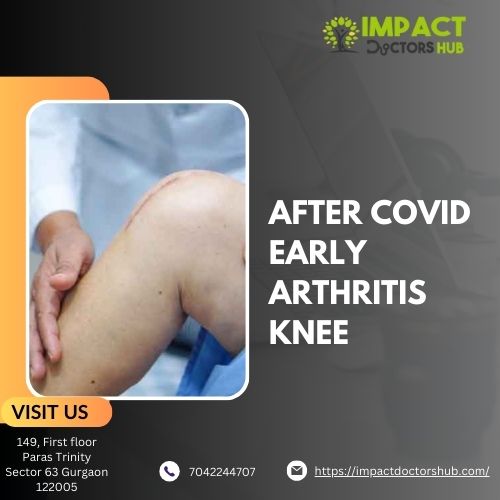
The COVID-19 pandemic has brought about numerous health challenges and one of the consequences that many individuals are experiencing is early arthritis in the knee. As people have been forced to limit their physical activities and stay at home, the lack of movement and exercise has taken a toll on joint health. Early arthritis in the knee can cause pain, stiffness, and a decrease in mobility, impacting daily activities and quality of life. This article brought to you by Impact Doctor Hub, will explore the effects of COVID-19 on knee health, the symptoms of early arthritis and methods for managing and preventing further damage. If you are someone who has been dealing with knee pain since the pandemic, keep reading to learn more about early arthritis in the knee and how to address it.
Understanding early arthritis in the knee after COVID-19
The sudden increase in cases of early arthritis in the knee after COVID-19 has raised concerns among healthcare professionals. While the virus itself does not directly cause arthritis, the lifestyle changes brought on by the pandemic have played a significant role in its development. The reduced physical activity due to lockdown measures has led to weakened muscles surrounding the knee joint. This weakened support system increases the pressure on the joint, leading to inflammation and the onset of arthritis.
Early symptoms of knee arthritis include pain, stiffness, swelling and difficulty in performing daily activities. It is crucial to seek medical attention promptly to prevent further damage. Treatment options range from physical therapy and medication to surgical interventions in severe cases.
Recognizing the symptoms and seeking medical advice
Recognizing the symptoms and seeking medical advice is crucial for effectively managing and preventing further damage in early knee arthritis post-COVID-19. The early symptoms of knee arthritis, such as pain, stiffness, swelling and difficulty in performing daily activities, should not be ignored or dismissed as temporary discomfort.
If you experience any of these symptoms, it is important to consult a healthcare professional. They will be able to conduct a thorough evaluation, including a physical examination and possibly imaging tests, to accurately diagnose your condition.
Early intervention is key in managing knee arthritis. The healthcare professional may recommend a combination of treatment options tailored to your specific needs. These may include physical therapy to strengthen the muscles around the knee and improve joint stability, medication to manage pain and inflammation, and lifestyle modifications to reduce stress on the knee joint.
In severe cases, surgical interventions such as arthroscopy or joint replacement may be necessary. However, most individuals can effectively manage knee arthritis with conservative treatment measures.
Remember, early recognition and seeking appropriate medical advice are vital in ensuring the best possible outcome for your knee health. In the next section, we will delve deeper into the various treatment options available for managing early knee arthritis post-COVID-19. Stay tuned for valuable insights and expert recommendations.
Treatment options for early arthritis in the knee
In this section, we will discuss the various treatment options available for managing early arthritis in the knee post-COVID-19. It is important to note that the treatment approach may vary depending on the severity of the condition and individual factors.
- Physical therapy: Physical therapy plays a crucial role in strengthening the muscles around the knee joint, improving flexibility, and enhancing joint stability. A physical therapist will develop a customized exercise program to address your specific needs and goals.
- Medication: Nonsteroidal anti-inflammatory drugs (NSAIDs) may be prescribed to manage pain and reduce inflammation in the knee. Your healthcare professional may also recommend other medications such as corticosteroids or hyaluronic acid injections to provide relief and improve joint function.
- Lifestyle modifications: Making certain lifestyle changes can significantly reduce stress on the knee joint. Maintaining a healthy weight, incorporating low-impact exercises like swimming or cycling, and using assistive devices such as knee braces or canes can help alleviate symptoms and prevent further damage.
- Assistive devices: In some cases, using assistive devices like crutches or knee braces can provide support, stability, and relieve pressure on the knee joint, especially during physical activities.
- Surgical interventions: In rare cases when conservative treatments do not provide sufficient relief, surgical interventions may be considered. Arthroscopy, a minimally invasive procedure, allows the surgeon to visualize and treat the knee joint using small incisions. In severe cases, joint replacement surgery may be necessary.
We must emphasize that the choice of treatment should be made in consultation with a healthcare professional who can provide personalized recommendations based on your specific condition and needs.
Physiotherapy and exercises for knee pain relief
After making lifestyle changes to manage early arthritis in the knee post-COVID-19, physiotherapy and exercises are crucial for further pain relief and improved mobility. Physiotherapy sessions under the guidance of a professional can help target the specific needs of your knee and provide specialized treatment plans. These sessions may include exercises to improve strength, flexibility and range of motion in the knee joint.
Physical therapists may suggest exercises such as leg lifts, hamstring stretches and quadriceps strengthening to strengthen the muscles supporting the knee. These exercises help stabilize the joint and reduce pain. Additionally, they may use techniques like manual therapy, ultrasound or electrical stimulation to manage pain and improve function.
It is important to follow the recommended exercise plan and attend physiotherapy sessions consistently to see optimal results. Remember, every individual’s condition is unique, so it’s important to work closely with a healthcare professional to develop a tailored exercise and physiotherapy routine.
Stay tuned for the next section, where we will delve deeper into the various physiotherapy techniques and exercises that can effectively manage early arthritis in the knee post-COVID-19.
Conclusion and looking ahead to a healthy recovery
In conclusion, after experiencing COVID-19, it is crucial to prioritize the care and well-being of your knee in order to facilitate a healthy recovery. By following the aforementioned self-care practices, you can effectively manage early arthritis in the knee and prevent further complications. Remember to give your knee ample rest and utilize ice and heat therapy for pain and inflammation relief. Additionally, consult with your doctor regarding appropriate pain management strategies and maintain a healthy weight to reduce stress on your knee joints.
Lastly, consider incorporating supportive devices such as knee braces or orthotic inserts to provide added stability. By prioritizing self-care, you can improve the health of your knee and enhance your overall well-being post-COVID-19. In the next section, we will explore further self-care practices that can contribute to your knee’s health and long-term recovery.
The introduction of Early Arthritis Knee Services at Impact Doctor Hub represents a forward-thinking response to the healthcare challenges posed by the pandemic. By embracing innovation, patient-centric care, and a commitment to early intervention, this initiative stands as a beacon of progress in post-pandemic healthcare. It exemplifies a new paradigm where healthcare providers prioritize prevention, tailor treatments to individual needs, and ultimately improve the overall well-being of those affected by knee arthritis.
